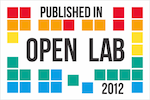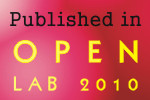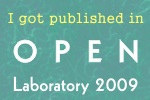For me, one of the more appealing aspects of open access publishing is that by making costs transparent it could stimulate competition between publishers and generate innovative solutions to drive down prices.
Today sees the launch of one such innovation: a new open access platform for life and medical sciences called PeerJ.
It is a fascinating gamble that may well pay off. According to the minimal information that has been available until now, PeerJ offers open access publishing at ‘$99 for life’, a price point that has intrigued onlookers. It seemed too good to be true, never mind economically viable. But in Peter Binfield, formerly of PLoS ONE, and Jason Hoyt, until recently a VP of R&D at Mendeley, the venture has co-founders who are deeply rooted in internet publishing and give every appearance of knowing what they are doing.
The details published today reveal that the reality of pricing is more complex and, in most cases, will work out to be more expensive than the trailed $99 figure. Nevertheless PeerJ is shaping up to be a highly competitive entrant in the burgeoning field of open access publishers.
The catches are three-fold. First, for your $99 you get lifetime membership that entitles you to publish just one paper per year. $169 gets you two papers per year but if you can stump up $259, then there will be no limit on the number of papers you can publish in PeerJ. It will only depend on how hard you work.
The second catch is that all authors (up to 12) need to be paid-up members for any paper that is accepted by PeerJ. So to begin with, the cost of publishing a paper with 10 or so authors won’t be significantly cheaper than going for PLoS ONE, which currently charges $1350. However, if you stick with the system — and I guess this is what Binfield and Hoyt are counting on — the longer-term costs will be minimal.
Sticking with the system is the way to avoid the third catch, which is that your membership will lapse if you don’t contribute at least one review per year. This can be a full peer review of a submitted manuscript or simply an informal comment on a paper in PeerJ (or one deposited with their planned preprint server). To my mind this condition isn’t much of a catch and is in fact a nice way of encouraging authors to participate in pre- and post-publication review. It gives PIs an incentive to get their students and postdocs involved in reviewing the literature.
For sustainability, PeerJ is looking to capture some of the megajournal market; clearly modelled along the lines of PLoS ONE, it will judge papers only on “scientific and methodological soundness”.
Will it work? I, for one, certainly won’t bet against them. Too many things are shifting in the publishing world right now for anyone to be sure about what lies ahead but it looks like Binfield and Hoyt have thought through many of the likely pitfalls.
There is perhaps a question mark about the capacity of the scientific community to support the volume of peer reviewing engendered by new open access journals — a strain that PLoS ONE already seems to be experiencing — but that is a difficulty that we will have to face together. For now I salute the innovation represented by PeerJ. The academic publishing industry just got more interesting.










I saw this story too
http://www.nature.com/news/journal-offers-flat-fee-for-all-you-can-publish-1.10811
You won’t expect me to comment much on this (disclosure for those who don’t know – I am an editor at Nature), except that (in my personal opinion solely) that
1) It’s a great idea;
2) I think that there is room in the publication ecosystem for a variety of business models.
However, I don’t think that PeerJ could be fully transparent, given that it is in receipt of start-up funds of an undisclosed amount. How has this affected its pricing structure, and is this likely to change?
Thanks Henry, I saw the piece in Nature just now – it’s has more detail and background than mine.
I gather that the start-up funds have been disclosed — as $950k from O’Reilly AlphaTech Ventures (OATV) and O’Reilly Media: see here.
I agree with you there is room in the ecosystem and that this is certainly an interesting new beastie.
Thanks Stephen – I stand corrected.
Henry – PeerJ did not disclose their start-up funds to me at the time I interviewed them, or that would have been in my article. Glad all public now.
Aha! Just goes to show you can’t believe all you read in the papers…
Hi Stephen, it will be really interesting to see if the $99 for a lifetime is a viable business model. Certainly an intriguing hypothesis…
Pingback: Your Peers, Your Science. Academic Publishing is Evolving. – PeerJ Blog | csid
Pingback: PeerJ open access publishing platform launches today | Scope Blog
As the 1st person on Twittter (other than someone from PLoS) who tweeted that Pete Binfield was leaving PLoS ONE to work on PeerJ, I was one of the 1st to spread the word of the early on stages of this significant development.
A few weeks later, I was the second person to learn of the involvement of Jason Hoyt. I know them both well and have met them IRL.
As someone who’s been involved in the periphery of (and more formally of late) STM Publishing since 2006, like everyone else (who is interested this stuff), with great anticipation, we awaited the actual details about PeerJ which only came out yesterday.
In real time, I did my best to capture what was being said online via this thread on G+ https://plus.google.com/u/0/107449381177524115065/posts/BKpn5hYX1VV
After me, Bora Zivkovic then did a further linkfest http://blogs.scientificamerican.com/a-blog-around-the-clock/2012/06/12/new-and-exciting-kid-on-the-block-peerj/
Then another from John Dupuis http://scienceblogs.com/confessions/2012/06/13/around-the-web-peerj-orama-why-twitter-matters-using-twitter-in-university-research-teaching-and-impact-activities-and-more/
And another, this time on the PeerJ blog http://blog.peerj.com/post/24981629979/peerj-linkfest
A LOT of coverage.
I fully concur with Stephen’s post and in agree that “The academic publishing industry just got more interesting”.
On a personal note, I extol my good friend Dr Gee Henry for commenting on these issues.
Thanks for all the links Graham. PeerJ have done pretty well to get the message out and, Scholarly Kitchen apart (but ’twas ever thus), the reception has been pretty favourable. At least, that is, among the commentariat. Will be interesting to see how quickly this diffuses into common-rooms and among people who are not plugged into social networks (though the coverage in Science and Nature will surely help).
Some of the most thoughtful commentary I have seen has come from Gavia Libraria.
What struck me was this:
“…your membership will lapse if you don’t contribute at least one review per year”
I’m going out on a limb to say that this will kill them. You want me to pay an annual subscription fee, but you also want me to contribute editorial content on a defined timeline? No thanks.
I predict a low membership level, and a lot of really, really crappy review articles. Oh, and by the way, how many review articles do they really need? If they have 1,000 paid-up members, that’s 20 per week. Who’s going to (a) edit, or (b) read all these reviews?
Just some thoughts.
Richard – I think you’ve misunderstood. A review is not a review article in this instance. It is either a piece of peer review of someone else’s manuscript submitted to PeerJ or can be as little as a public comment on one of their published articles.
So there is a bit of quid pro quo in the cheap membership fee but it’s not nearly as onerous as you suppose.
Ah, thanks for the clarification. As a card-carrying Associate Member of the Faculty of 1000, I can still say that getting people to actually contribute even capsule reviews or comments is likely to consume all of PeerJ’s time (based on the effort F1000 puts in to trying to get me to do the same… n=1 of course).
It’s an interesting development. I wonder if it might appeal (mostly, best, etc?) to those working in small groups or solo?
PS: if any of you London-based chance upon someone looking like me pottering about the South Kensington museum area today, it might just be me
Pingback: Around the Web: PeerJ-orama [Confessions of a Science Librarian] « Random Information